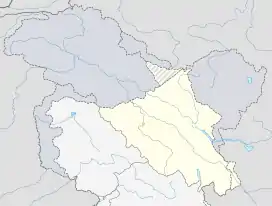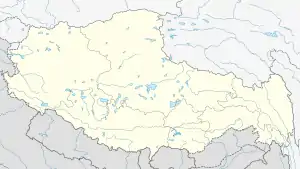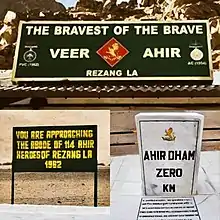Rezang La
Rezang La is a mountain pass on the Line of Actual Control (LAC) dividing the Indian-administered Ladakh and the Chinese-controlled, but Indian-claimed, Spanggur Lake basin, administered as part of the Rutog County. It has an elevation of 5,500 metres (18,000 ft), and forms the source of the Rezang Lungpa stream that drains into the Spanggur Lake. It is 11 miles south of the Spanggur Gap, on the ridge line that China claimed as its 'traditional customary boundary' during the 1960 border talks.[1]
| Rezang La | |
|---|---|
| रेजांग ला | |
  | |
| Elevation | 5,500 m (18,045 ft) |
| Location | Ladakh, India |
| Range | Himalaya, Ladakh Range |
| Coordinates | 33°24′50″N 78°52′29″E |
Rechin La (or Reqin La) (Chinese: 熱欽山口) 33.42°N 78.85°E, 6 km northeast of Rezang La is another border pass which also lies on the Line of Actual Control and forms the source of another stream. This pass has roads leading to it on both the Chinese and Indian sides of the LAC.[2]
Geography


Rezang La and Rechin La are mountain passes on the ridge line adjoining the Chushul Valley, which China claims as its border. India's claim line is further east, and it coincides with the border shown on most British and international maps prior to Indian independence. The Line of Actual Control (LAC) resulting from the 1962 Sino-Indian War coincides with the Chinese claim line in this region.
From northwest to southeast the LAC passes through the Finger 4 area on the northern shore of the Pangong Lake and the Helmet Top hill on the southern shore, then the Black Top hill and Gurung Hill, Spanggur Gap, Magar Hill, Mukhpari hill, Rezang La and Rechin La. Rezang La is 17 km away from Spanggur Gap and Rechin La is 24 km away.[2]
The Chushul village and Indian military post are 27 km northwest of Rezang La. The road from Chushul eventually leads to Leh city in the west.
Military operations
1962 battle of Rezang La
During the Sino-Indian War in 1962, Rezang La was the site of the last stand of the 13 Kumaon, comprising the Charlie company. The company was led by Major Shaitan Singh, who won a posthumous Param Vir Chakra for his actions.[3][4][5] From the Indian point of view, Rezang La had the drawback that an intervening feature blocked artillery operation, so that the Indian infantry had to do without artillery cover.[5]
In this action on 18 November 1962, 114 Indian soldiers out of a total of 120 (Ahirs) were killed. A memorial in Rewari, where most of the Ahir soldiers came from, claims that 1,300 Chinese soldiers were killed in the battle.[6] The Indian side was led by Major Shaitan Singh (IC 7990) a Bhati Rajput From Rajasthan State, who was later posthumously awarded Param Vir Chakra, India’s highest gallantry award for conspicuous bravery and self-sacrifice in the face of the enemy.
2020 border standoff
During border standoff in summer, the Indian Army deployed troops along the Line of Actual Control south of the Pangong Tso, including at Rezang La and Rechin La. This was said to give them a commanding view of the Spanggur Gap and China's "Moldo sector" (the deployments around the Spanggur Lake).[7]
War memorials (Ahir Dham)
Rezang La War Memorial at Chushul

The inscription on the War Memorial at Chushul, Ladakh raised by the Indian Army in memory of the soldiers who died in the Battle of Rezang La, reads as below.[8][9] The first four lines are quoted from Horatius, a poem by Lord Thomas Babington Macaulay, member of the Governor-General of India's Supreme Council from 1834 to 1838[10]
How can a man die better,
Than facing fearful odds,
For the ashes of his fathers,
And temples of his gods.
To the sacred memory of
the heroes of Rezang-La
114 martyrs of 13 Kumaon
who fought
to the last man last round
against hordes of Chinese
on
18 November 1962.
Built by all ranks
13th Battalion the Kumaon Regiment.
Major-General Ian Cardozo writes in his book "Param Vir, Our Heroes in Battle":
When Rezang La was later revisited dead jawans were found in the trenches still holding on to their weapons... every single man of this company was found dead in his trench with several bullets or splinter wounds. The 2-inch mortar man died with a bomb still in his hand. The medical orderly had a syringe and bandage in his hands when the Chinese bullet hit him... Of the thousand mortar bombs with the defenders, all but seven had been fired and the rest were ready to be fired when the (mortar) section was overrun.
General T.N. Raina lauded:[11]
You rarely come across such example in the annals of world military history when braving such heavy odds, the men fought till the last bullet and the last man. Certainly, the Battle of Rezang La is such a shining example.
Rezang La War Memorial at Rewari
General K S Thimayya wished for a memorial to be built in Ahirwal region of Haryana in the memory of soldiers who were mostly from this area. He felt generations to come would seek inspiration from the immense courage and valour of their forefathers.[11] Consequently, another Rezang La war memorial was constructed by Rezangla Shaurya Samiti inside Rezang La Park near Dharuhera Chowk in Rewari city in Ahirwal region. Annual memorial function is held by the Samiti in collaboration with district administration, the Kumaon Regiment and family members of those who died at Rezang La also participate.
See also
References
Citations
- Sinha & Athale 1992, p. 334 (The source gives the distance incorrectly as 11 km instead of 11 miles.)
- India sits on Black Top with Helmet under its boots, The Print, 9 September 2020.
- Press Information Bureau, Government of India (7 January 2007). "Remembering Rezang La heroes". Sainik samachar.
- Col Dilbag Dabas (Retd) (15 December 2018). "Heroes of Rezang La 1962". The Tribune.
- Mohan Guruswamy (20 November 2012). "Don't forget the heroes of Rezang La". The Hindu.
- Shekhar Gupta (30 October 2012). "'Nobody believed we had killed so many Chinese at Rezang La. Our commander called me crazy and warned that I could be court-martialled'". The Indian Express.
- Manu Pubby, Chushul tense: Chinese troops within firing range of Indian soldiers, The Economic Times, 1 September 2020.
- "Photograph of the memorial". bharat-rakshak.com. Archived from the original on 28 January 2014.
- "War Memorial of 13 Kumaon". Bharat Rakshak. Archived from the original on 2 February 2014.
- Thomas Babbington Macaulay. "Lays of Ancient Rome". Gutenberg.org. Retrieved 8 April 2016.
- Atul Yadav, Injustice to Ahir martyrs of 1962 war, Tribune India, 18 November 1999.
Bibliography
- Sinha, P.B.; Athale, A.A.; Prasad, S. N. (1992), History of the Conflict with China, 1962 (PDF), History Division, Ministry of Defence, Government of India